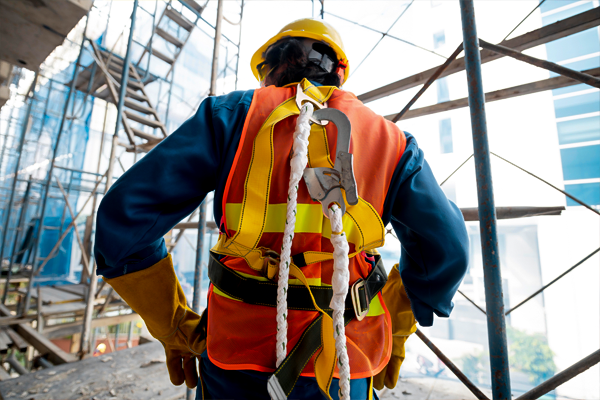From building new homes, to keeping infrastructure up-to-date and safe – construction workers play an essential role in making our country the forefront of progress.
Without them, we wouldn’t have cities bustling with life or industry that moves us forward each day!
In 2021, the U.S. Bureau of Labor Statistics gave us a startling statistic: over two and a half million workers in private industry suffered from accidents or illnesses – testifying to precisely how challenging life on the job can be!
Construction crews brave the risks of a hazardous occupation every day—from operating heavy machinery to erecting towering edifices. Despite safety regulations and precautions, too many workers are still being injured or killed in construction-related accidents annually.
It’s an unfortunate reminder that no amount of preparation can fully protect those hardworking men and women risking their lives on job sites each day.
Construction sites can be dangerous environments, both due to the nature of work and a wide variety of accidents that may occur. But despite project variations, there is an underlying trend amongst construction site related injuries – one which when understood could help boost safety protocols even further.
From minor scrapes to grave fatalities, construction sites are no strangers to dangerous hazards. Here we look at some of the most notorious accidents and injuries associated with this occupation.
Construction workers who have suffered from an on-the-job injury could be experiencing tremendous physical, financial and emotional strain. If you are in this position, Florida legislation has ensured your rights to justice and protection so that you can continue forward with the best outcome possible.
It’s essential to know what those protections entail – don’t hesitate to become informed of every right available!
Construction sites can be dangerous places—but what types of injuries are especially prone to occur? Slips, trips, and falls top the list due to slippery surfaces or debris littered on walkways. In addition, strains from manual labor as well as cuts and lacerations may also present a threat while working with heavy machinery.
Be sure that safety measures are taken when tackling any construction project!
Construction workers face serious potential dangers on the job, from slips and falls to hazardous materials.
According to OSHA, these are the most common sources of injury: electric shock; falling objects; scaffolding collapse or other structure failures; exposure to harmful chemicals or airborne particles; overexertion or fatigue-related incidents due to inadequate safety practices such as not wearing personal protective equipment (PPE); vehicle collisions with construction sites/workers walking in work zones without proper warning signage.
It’s imperative for employers and those working at a site adhere strictly to best practice guidelines that ensure safe conditions for everyone involved.
1. Construction Site Electrocution Injuries
Construction work is often unavoidably close to high-voltage electricity sources, leaving workers dangerously exposed.
Despite protective protocols and warnings aimed at prevention of injury, electrocution accidents still occur on job sites – underscoring the need for extra caution when near power lines or other energy generating equipment.
Electrocution can be a devastating experience, with possible consequences ranging from burns to cardiac arrest and nerve damage.
How Do Construction Workers Get Electrocuted?
In everyday life, contact with metal objects is unavoidable. But when those same items become electrically charged from power sources like ladders and wires, they can put others in danger of electrocution or shock.
That’s why it pays to be extra careful around energized trucks and other vehicles, as well as tools that may inadvertently cut through electricity-charged metals pipes or wires!
Working on a construction site can be incredibly dangerous for workers, as evidenced by the number of workers who are injured or even killed each year due to electrocution. Among workers compensation Florida claims in high-risk jobs, those related to electrocutions hover near the top of the list.
If you or someone you know has been injured at work from an electrical shock, it’s important to understand your rights and seek appropriate compensation.
Suffering an electric shock at work can be a traumatic experience, especially in more serious cases. Even if you don’t have any electrical expertise or certifications, it’s possible to make a claim for damages should the incident occur as due to negligence such as faulty equipment maintenance and lack of adequate training.
With enough awareness and prevention measures, we can help reduce the number of workers suffering from preventable electrocution injuries at construction sites.
To help prevent such tragedies, OSHA regulations are in place that focus on everything from addressing safety requirements to the proper design of electrical equipment. Additionally, utilizing protective devices like insulation is essential for maximum protection against electrocutions.
2. Fall Injuries on Construction Sites
Working on construction sites comes with a raft of potential dangers, one being falls from great heights. Construction sites can be hazardous, as falls are a common cause of injury. Falls account for around 35% of all accidents at these job sites and can result in serious injury or death if not prevented correctly.
To help prevent these accidents, workers must pay extra attention to uneven surfaces; practice proper mounting and dismounting from machinery; make sure ladder use is safe; and always utilize fall protection equipment for added security.
Factors that impact the severity are how far to the ground a worker was when they fell, as well as whether any safety equipment is present, such as protective scaffolding or ladders.
Unfortunately, many times no security measures exist because workers often build up projects entirely from scratch making it hard to strategically plan ahead against risks like falling off roofs, chimneys etc…
Even with safety measures in place, workers still need to be aware of the potential risks and take any necessary precautions to prevent an accident from occurring. It is essential for employers to provide training and instruction on how to properly use protective equipment and recognize red flags that may lead to a hazardous situation. Employers must continue to update the protocols in order.
In 2020, a grim statistic emerged: one out of every five workplace deaths occurred in the construction industry. More specifically, falls to lower levels accounted for an alarming 46.1% of all fatal slips and trips that year. Making matters worse – this number remains consistent with past years’ trends according to U.S Bureau of Labor Statistics data!
Broken Bones From Construction Site Falls
Falls can cause more than just a bruise or scrape – they may lead to broken bones, which vary in severity from minor fractures to major breaks.
Painful and frightening at times, treatment of broken bone injuries range from simple bandaging to complex surgery, depending on the location and extent of damage sustained by the individual.
Back Injuries In Construction
One of the most common types of injuries caused by falls on construction sites is back injuries. Back injuries can range from minor strains and sprains to more serious injuries such as herniated discs or spinal cord damage.
Falls from heights are a particularly common cause of back injuries in construction workers.
Back injuries are the costliest construction-related hazard, with 25% of all reported cases annually. Unfortunately, even one injury can be devastating; leading to an average seven workdays away from their job, as well as increased risk for permanent damage and career ending complications.
Spinal Cord Injuries Caused by Falls on Construction Sites
Spinal cord injuries caused by falls on construction sites amount to more than their fair share of workers compensation claims in Florida alone.
Spinal cord injuries, especially those that cause paralysis, have a serious impact on the quality of life of those affected.
An injured construction worker might not only feel significant physical pain and suffering, but also worry about what measures their employer has put in place for workers compensation. That’s why it’s important for workers to know and understand their rights, especially if they have been injured at work.
3. Machinery Injuries on Construction Sites
Working on construction sites comes with a raft of potential dangers, one being falls from great heights. Construction sites can be hazardous, as falls are a common cause of injury. Falls account for around 35% of all accidents at these job sites and can result in serious injury or death if not prevented correctly.
Despite the remarkable advances made in terms of efficiency, working with heavy machinery still comes packed with its own set of hazards.
Accidents involving these machines are unfortunately one of the leading causes for workplace mishaps on construction sites – a reminder that safety should always be top priority!
Construction machinery accidents can happen when you least expect it: health risks, malfunctioning equipment, and unsafe conditions all pose potential dangers. Being aware of the common hazards will help protect workers on-site from any unwelcome surprises.
What Are Common Construction Machinery Related Injuries?
Despite the remarkable advances made in terms of efficiency, working with heavy machinery still comes packed with its own set of hazards.
Accidents involving these machines are unfortunately one of the leading causes for workplace mishaps on construction sites – a reminder that safety should always be top priority!
Construction machinery accidents can happen when you least expect it: health risks, malfunctioning equipment, and unsafe conditions all pose potential dangers. Being aware of the common hazards will help protect workers on-site from any unwelcome surprises.
4. Construction Site Collapse Injuries
Construction sites can be hazardous for workers due to the potential of building and ground collapses.
This tragedy, which is often devastating in both human cost and financial expense, could occur when structures are poorly maintained or undermined by geological instability such as shifting soils.
Before a skyscraper can reach for the sky, construction workers must start below ground. With dangers of cave-ins and collapses looming overhead, these brave contractors take on an incredibly risky job to dig foundations, run utilities and lay down groundwork.
The potentially devastating consequences of a building or ground collapse are not to be taken lightly; many have found that even the most skilled construction worker is no match for Mother Nature.
Trench Collapses in Construction
From suffocation due to mud and soil caving in, to head trauma resulting from accidental falls – these disasters can typically result in deathly outcomes if precautionary safety measures aren’t enforced.
To ensure workplace safety of those working in excavations, and compliance with OSHA regulations, employers are required to provide shoring, shielding or sloping protection when necessary. This will provide a critical defense against cave-ins.
Sadly though, far too many supervisors ignore installing such safeguards due to time and cost pressures – leaving workers without this vital safeguard against soil walls.
Foundation Collapses in Construction
When foundations lack proper design and construction, the weight of a building can cause catastrophic collapse. Without stable support beneath it, any structure is at risk for instability– putting workers in danger from floor to ceiling.
Rooftop cave-ins can be devastating, yet they are often the result of poor planning decisions and shortcuts.
A combination of heavy machines or loads on a structure without sufficient supports, cost-saving measures such as low quality building materials, and overlooked risk factors during inspections could all lead to catastrophic consequences.
5. Construction Site Trip Injuries
Construction sites can be dangerous places if you don't take the right precautions – particularly when it comes to slips, trips and falls.
Wet surfaces, debris-laden floors, loose ladders or scaffolding structures are just some of the common hazards that could lead to serious injury on a construction site – not forgetting more unexpected dangers such as vehicle-related risks and weather conditions.
And all this is before discussing potential obstacles created by hoses left lying around unsecured in dimly lit areas! It’s always important to stay vigilant while carrying out any kind of work at a building site.
A trip can happen in the blink of an eye, but the consequences may last much longer. Tripping is a common cause of injuries ranging from mild to severe – traumatic brain injuries (TBIs), spinal cord damages, broken hips or pelvis fractures, shoulder and neck injury trauma, limb breaks and even torn ligaments are all risks when you stumble.
What Does OSHA Consider a Tripping Hazard?
Working environments can contain hidden dangers – any object in the path of a person’s feet that could trip them or cause traction loss is considered a tripping hazard. Common examples include cables, paper, boxes, and hoses left carelessly lying around pathways.
OSHA urges employers and employees to keep work environments safe by making sure hazardous holes or openings are properly covered.
Openings 30 inches tall and 18 wide need covers, railings for tripping prevention, as well as toe boards if there’s the possibility of tools falling into it or people passing under.
All these measures ensure any workplace remains secure from falls and accidents!
6. Construction Site Vehicle Accidents
Construction work is often seen as a rewarding career despite the risk of injury.
Aside from falls and machinery, many construction personnel are unaware that site vehicles can be equally if not more dangerous to workers on-site. Knowing the risks associated with every aspect of your job will help ensure you stay safe while at work!
Construction site vehicles can cause life-altering injuries, putting you out of commission for an indefinite period that could span weeks to months or even beyond.
Construction sites are home to an array of heavy vehicles and earth-moving equipment, which help make large projects easier for workers.
Yet these powerful machines can also be a potential hazard in inexperienced hands or when passing through hazardous zones – the safety of those onsite must always take priority.
With over 3,000 lives lost and 40,000 people injured each year from vehicle incidents at work zones – it’s clear that this is a serious risk to employees.
OSHA emphasizes the importance of proper safety training when vehicles are present in order to protect workers on-site.
Construction Site Vehicle Collision Accidents
Construction workers face an unnecessary risk of harm due to reckless driving and accidents.
Collisions or rollovers are the most common types of vehicle mishaps, but they can be particularly hazardous for construction personnel who don’t have any protection from a cab inside their rigs.
Plus, these heavy-duty vehicles tend to cause extensive damage when involved in crashes with other automobiles or pedestrians onsite.
Construction Site Vehicle Pinning Injuries
From construction sites to warehouses, workers can all too easily become the victims of a dangerous situation: pinning.
Without vigilant attention from operators or brakes that fail to engage in time, vehicles and heavy machinery might roll into those on foot nearby – leading to awful crush injuries as they’re pinned between objects.
Construction Site Vehicle Back-Up Accidents
Every year, 70 workers tragically lose their lives due to back-over incidents that were preventable.
These accidents happen when a vehicle strikes someone walking or standing behind it and are often caused by drivers who fail to properly check the area around them for hazards such as people in blindspots not visible from the driver’s seat.
Knowing these risks is key so steps can be taken towards keeping everyone safe on job sites everywhere!
7. Construction Site Repetitive Motion Injuries
What Are Repetitive Motion Disorders?
Repetitive motion disorders (RMDs) can be the result of normal work and daily activities, but they occur when too many repetitions are done without interruption.
Repetitive strain injuries are a growing concern in many workplaces, especially those that involve frequent repetitive motions.
Even the activities we do for leisure can cause damage if performed too often without proper protection or conditioning – so it’s important to be aware of potential risks and take steps to remain safe while performing any type of work duty!
Industries where employees are exposed to the dangers of repetitive tasks have an increased risk for injury.
These jobs often involve continuous, repeated motions that can create physical strain over time. To ensure safety and well-being in these industries, it is essential workers remain aware of potential hazards associated with their job duties.
Transportation related jobs, food preparation workers, manufacturing positions, retail positions, entertainment workers, office workers, sewing positions, construction workers, and more – are all jobs that require repetitive motion.
Posture, motions such as twisting an arm or wrist, overexertion and muscle fatigue all contribute to RMDs like carpal tunnel syndrome; tendonitis in elbows, shoulders, or wrists; radial/ulnar epicondylitis (tennis elbow); trigger finger/thumb; rotator cuff injury and De Quervain’s Syndrome.
Working without taking the time to recover can put workers at a higher risk of serious construction hazards – musculoskeletal disorders (MSDs) being one of them.
These injuries, such as shoulder and low back strain, carpal tunnel syndrome or tendonitis usually begin with minor aches and pains but if ignored they could worsen over time leading to long-term damage.
Being aware of what causes these symptoms is key for avoiding unnecessary complications in the future!
Protecting your employees is not only the responsible thing to do – it can save you from potentially devastating financial costs, too.
Without a workers’ compensation program in place, small businesses are particularly vulnerable when faced with paying out-of-pocket for an employee’s strain injury or legal fees associated to such matters.
Ensure that both yourself and your staff have all bases covered: consider investing in our workers’ comp program today!
Workers compensation is a state-mandated insurance program that provides benefits to employees who are injured or become ill as a result of their job.
If you’re an employer, it’s important to have workers comp coverage in place to protect your business and employees.
At OCMI, we’re experts in PEO brokerage and can help you find the best and most affordable PEO program for your business. So if you’re looking for the best workers comp coverage at the best price, look no further than OCMI!
We’ll make sure you get the protection you need at a price that fits your budget.
And remember: to prevent injury or death from occurring onsite, it’s critical that rigorous safety protocols are followed during construction projects of all sizes.






